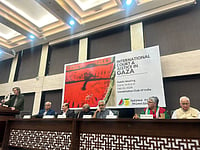Two mattresses stacked together and a torn bed sheet. Some pillows and utensils scattered around. A make-shift chullha to cook. And a pack of polythene bags to defecate. This has been the life of 40-year-old Seema Mallick in Jawahar Shramik Sthal, Yamuna Ghat, since the eight shelter homes were demolished on March 10 as part of a beautification drive for G-20. With her six-year-old daughter, Seema, who recently lost her legs in an accident, spends her entire day watching the city where people lose their homes in seconds. She waits for change but isn’t hopeful.
“Gareeb ki baat koi nehi suntey, gareeb ko koi nehi dekhte…” (No one listens to the poor, we are invisible)
Inebriated and restless, these are the only words people along this stretch of the Yamuna, near Kashmere Gate, utter whenever anyone visits them. Without a secure roof over their head, the displaced people between Qudsia Ghat and Nigambodh Ghat have now made homes out of broken pieces of the shelter homes which were demolished late at night last month. And those who could not, lie in the open.

“No notice was served, and nothing was informed before a platoon of Delhi Police and the military along with a few DDA (Delhi Development Authority) officials came and destroyed our decade-old shelter homes. Most of our belongings were damaged and some of us were lathi-charged while trying to resist,” says Pintoo, a migrant labourer from West Bengal’s New Jalpaiguri who was staying there for the past four to five years.
Pintoo along with ten other people now keep moving around with a few utensils and bedding, finding temporary spaces to stay, until the security forces come to uproot their homes once again.
“The demolished shelter homes were used by nearly 5,000 people who are daily wage earners or do other odd jobs like ragpickers, cleaning etc. These shelters provided them with a sense of home. But no more,” says Sunil Aledia, who runs the Centre For Holistic Development.
Aledia and other land rights activists say that the demolition drive is part of the “beautification drive” ahead of the G20 summit slated for September, later this year. And this has been leading to “anti-encroachment drives” across Delhi, where foreign delegates are scheduled to visit, rendering people homeless.
According to a report by The Print, the overall bill for the city’s upgrade is expected to run up to about Rs 1,000 crore. In February, Delhi Lieutenant Governor V.K Saxena held a high-level meeting to review progress on the G20 makeover. He also visited various sites in the city and instructed officials to speed up their work.
“Why else would the authorities break homes they built by spending nearly 16 crores of money? According to sources, the Jawahar Shramik Sthal will be turned into a parking area for the G20 summit and eventually, for tourists. But no rehabilitation has been made for those who have stayed here for years,” Aledia tells Outlook.

However, 70-80 people, although have been sent to shelter homes in Dwarka, those rainbaseras allegedly lack the basic condition required to eke out a living.
“Most of the time, the places where they are rehabilitated to are far away, often violating the UN Basic Principles and Guidelines on Development-based Evictions and Displacement. Further, they are just given ‘land’ without any sense of development and the state believes that is enough. But no,” says Anagha Jaipal associated with Housing and Land Rights Network.
Speaking to Outlook, Anagha explains how the burden to make a living always falls back on those who have been evicted in the first place. “When families move from here to there, there’s a burden for them to create a life for themselves once more, far away from where they had lived. Our surveys have revealed the poor quality of construction and how desolated the rehabilitated areas are. Does a mere act of providing houses make it enough to provide livelihood? They are taken away from where they worked, where their children went for schooling and where they had made a community of their own with no attention given to the social conditions.” She points out that is the reflection of what the state thinks they are --- disposable.
Leaning against a barren branch in the scorching heat, Ali, an elderly man, who undertakes cleaning services at the Nigambodh Ghat, says, “Our work is based on where we stay. We are daily wage earners and many of us work at the Nigambodh Ghat undertaking. Now they have uprooted us and are telling us to go to faraway places! Why should we go? Do they care about our needs?” Ali adds that the housings in Dwarka are already overcrowded.
Water woes
Besides, facing the lack of housing, people here have no water. The only handpump that was installed here has been destroyed on the same night. No reasons were ever specified. Nobody came later to check on how people here are surviving without water.
“The water tank comes here once around 11 am and that is when we all gather our containers to store the water. The rest of the time, we resort to the polluted water of the Yamuna,” says Seema, whose daughter has to make her way through the groups of intoxicated men to fetch water.
Right behind where Seema sits idle, runs an overhead pipe, mostly covered in algae. And that has become a major source of water for people there. Buckets are placed under a tiny leakage of pipe where it takes about half an hour for the tiny droplets to fill the buckets.
Aledia believes that this time the social situation of the people staying in shelter homes and jhuggis is worse than what the Commonwealth Games saw in Delhi in 2010.

For Seema, life has turned worse since then. Heavily dependent on her young daughter and her husband, who works as a waiter at weddings, Seema fears that in their absence the police and military ‘men’ might take her away and no one would ever find her.
The fear of police does not stop at this part of the ghat. Nearly two kilometres away from the Qudsia Ghat, at Moolchand Basti in Bela estate, nearly 700 families live in constant fear of police intrusion and vandalisation.
Moolchand basti
On March 28, the DDA officials along with the Delhi Police issued an eviction notice at 3pm to the residents and within an hour, a demolition drive started.
“They treat us worse than terrorists. Even terrorists are given the bare minimum time to express their last wish. And look at us, almost every day since March 28, we are being threatened to leave or they will destroy all that we have,” Hira Lal breaks down as he mounts his belongings on a truck and sends them to a faraway village before his family loses everything.
Aledia says that ahead of the G-20 summit, the government wants to create a bio-diversity park in this place the way they have constructed the Golden Jubilee Park just behind Moolchand near Raj Ghat.

Hira throws bundles of documents showing evidence of their residence prior to 2006 which make it their right to be rehabilitated and own this land. However, nothing has been provided as of now.
According to the Delhi Slum & JJ Relocation and Rehabilitation Policy, 2015, the cut-off date for eligibility for alternative accommodation for slum and jhuggi-jhopri (JJ Cluster) dwellers had been revised to January 1, 2015, from 2009; these, however, must have been in existence prior to January 1, 2006. No jhuggi built after January 1, 2015, will be allowed. As per the policy, the name of jhuggi-jhopri dweller must exist in at least one of the electoral rolls of 2012, 2013, 2014, and 2015 and also in the year of the survey, for the purpose of rehabilitation. JJ clusters, which have come up before January 1, 2006, will not be demolished without providing alternative accommodation, as per the proposed policy guidelines.
“We have appealed to the court, ran pillars to post between different ruling parties, paid money to DDA for owning lands, worked as BJP volunteers ahead of the 2019 Lok Sabha elections, and have provided all the documents, which suddenly become valid during elections. And then we are declared as “illegal encroachers” when it comes to commercialising our lands,” says Heera.

However, the court cannot give protection until the clusters are surveyed by the Delhi Urban Shelter Improvement Board (DUSIB) and declared as “notified clusters”, and if it's not notified, the court refuses to give protection. And since they refuse to give protection, there’s no rehabilitation.
“As per the policy, DUISIB is supposed to give protection to all settlements and survey them first. But what we see is a violation of the policy,” says Anagha, who opines, that the ownership of public land, by virtue, lies on the public and the state and “nobody is encroaching”.
During 2017-21, a total of 1,91,070 houses were demolished and 9,48,493 people were evicted in India, according to a 2022 report by Housing and Land Rights Network India (HLRN).

When Outlook tried to reach out to DUISIB, no comments were available.
“The entire act of displacement becomes political because they are not given a choice. Their choices are not highlighted. Their access to lands in rural areas is so limited that they are forced to migrate. Further, belonging to certain castes and all these intersectionalities when combined, make them homeless adding to the intergenerational poverty.”
For them, the promise of 'Jaha Jhuggi Waha Makkan', remains a distant dream. Perhaps no amount of beautification can hide the poor or poverty in India’s heartland.


























